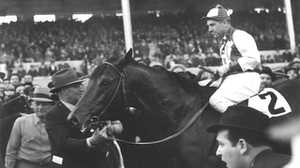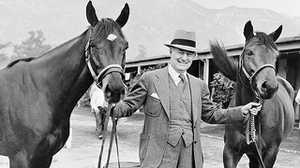War Admiral

For all the attention writers and filmmakers heap on Seabiscuit today, the horse was not considered the fastest Thoroughbred for most of his racing career. That distinction went to War Admiral, the son born to the regal mare Brushup and sired by the horse many consider the greatest Thoroughbred of all time, Man o'War.
Like His Daddy
In the spring of 1937, War Admiral dominated every stage of every race he entered. When he won the Kentucky Derby that year, Neville Dunn, sports editor for the Lexington Herald, wrote, “A little brown horse that takes after his mammy in size but runs like his daddy charged to victory in the 63rd Kentucky Derby… and he won so easily, so effortlessly, that 65,000 fans nudged one another in the ribs and said, 'I told you so! I told you that War Admiral could run like Man o’ War.’”
Triple Crown
Next, War Admiral took the Preakness. At Belmont, the third leg of the Triple Crown, the Thoroughbred repeatedly crashed through the gate, as he was wont to do, delaying the start for nearly nine minutes. At the bell, he bounded so powerfully onto the course that his hind feet overran his front, and the toe of his hind shoe gouged into his right forehoof. He left behind an inch-square chunk of his forehoof on the track. In just ten leaps, though, he was beyond the entire field. By race’s end, he had left a trail of blood and beaten horses, cracking the course’s track record, which had been held by his father, to become the fourth winner of the coveted Triple Crown.
Unlikely Rivals
War Admiral was a sleek and elegant horse. He had the glistening muscles of a warrior. In contrast, Seabiscuit was low slung and had an awkward gallop. Seabiscuit also had a tendency to overeat and was far more low-key than his rival, sleeping far longer than other horses could. The horses also had completely different racing styles. Seabiscuit was a fair starter, but usually had to weave his way through the pack, relying on consistent speed, endurance, and a burst of speed at the end to win. High strung like his father, War Admiral would bolt onto the racetrack. He was like a racecar engine, quickly accelerating to high speeds and then maintaining them. Even the horses’ owners were opposites: Samuel Riddle, War Admiral’s owner, was haughty, spoke little, and intensely distrusted the press corps; Seabiscuit’s owner, Charles Howard was garrulous, friendly and courted reporters.
The Match Race
In December 1937 after winning a remarkable eight of eight starts for the season, War Admiral was named horse of the year by a sportswriters’ poll in Turf and Sport Digest. Seabiscuit came in second. A few people believed the only horse who might challenge the Admiral was Seabiscuit, and after a few failed attempts to arrange a match-up, the two owners signed on to a winner-take-all race at Baltimore’s Pimlico Racecourse on November 1, 1938. The unlikely rivals would run what many racing aficionados consider the greatest race in the history of the sport.
Conventional Wisdom
Every writer for the Daily Racing Form picked War Admiral to win and 95 percent of all other journalists believed that aristocracy would whip the Western upstart. “[I] am one of the narrow-minded group which has seen War Admiral run too often,” San Francisco Chronicle columnist John Lardner wrote, “to concede Seabiscuit a chance for anything better than a seat in Congress this year.”
Popular Opinion
The Pimlico match race drew nationwide attention. It played on regional rivalries and on the preference of Depession-era Americans for the underdog. If a horse like Seabiscuit could triumph over the worst hardships, many Americans must have felt, so could they. “The whole country is divided into two camps,” noted journalist David Boone. “If the issue were deferred another week, there would be a civil war between the War Admiral Americans and the Seabiscuit Americans.”
High Drama
The biggest surprise in the match was that Tom Smith had re-trained Seabiscuit to bolt at the sound of the bell. He lunged ahead of War Admiral immediately. Seabiscuit took the lead, an unaccustomed place for him. War Admiral caught his rival and the two rode side by side to the top of the stretch. Then Seabiscuit sprinted ahead. Some said he had more in reserve; others said he had greater heart. He won by four lengths, clocking in at 1 minute, 56 and 3/5 seconds, a track record. “Seabiscuit did just what I thought he’d do,” said Red Pollard, Seabiscuit’s usual rider. “He made a rear admiral out of War Admiral.”
Retired to Stud
Riddle retired War Admiral after the horse won 21 of his 26 races, and the stallion spent two decades fathering excellent racers. But in the end, what most Americans would remember about the remarkable horse was not his stellar career, but his epic battle with — and decisive loss to — Seabiscuit.







